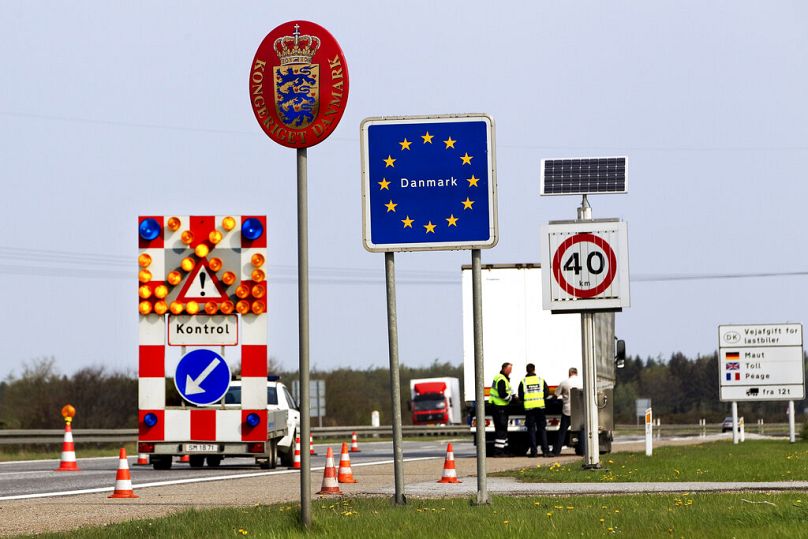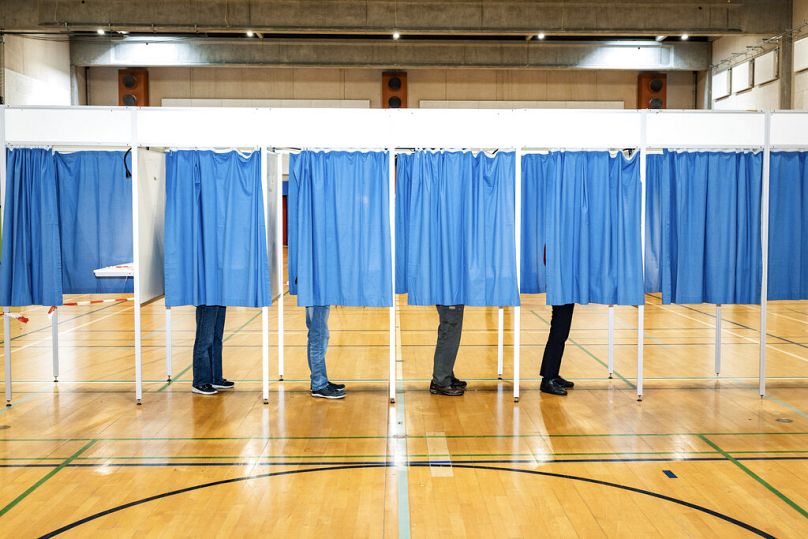As Danes go to the polls on 1 November, here's everything you need to know about the vote.
Denmark goes to the polls on Tuesday 1 November in a snap general election called seven months ahead of schedule.
Here's everything you need to know about Danish politics, parties, personalities and the issues at stake as the Nordic nation votes:
How did we get here?
Prime Minister Mette Frederiksen has headed a minority Social Democratic government since June 2019, but her popularity has slumped over the last few months due to her role in a pandemic-era decision to cull Denmark’s entire captive mink population.
A commission appointed by parliament harshly criticsed Frederiksen's government for its decision to order the killing of millions of healthy mink at the height of the coronavirus pandemic to protect humans from a mutation of the virus.
That saw one of the government’s centre-left allies, the Social Liberal Party, threaten a confidence vote unless Frederiksen promised to call an early election.
How does an election in Denmark work?
Up for grabs on 1 November are 179 seats in the Danish Parliament -- or Folketinget -- including two representatives each from Greenland and Faroe Islands (voting in Faroe Islands will happen on 31 October due to a local public holiday on 1 November).
In fact, by the time you read this article voting has already started in the election, as advance votes can be cast up to three weeks ahead of 1 November in town halls around the country. This is for people who are not able to vote on election day itself, but it's also available to people in nursing homes, prison inmates, and at some Danish embassies overseas.
For example, these Danish troops on a NATO mission in Estonia voted in mid-October:
Overall voter turnout is usually high in Denmark, and it wouldn't be a surprise if there was more than 80% turnout. However there is a particular effort to get first-time voters - young people and new citizens - engaged in the process.
Every election cycle, parliament sends out a booklet about the constitution and the voting process and includes a funny cartoon on the envelope which apparently has a positive effect.
"Research has shown that the cartoon has a positive effect on first-time voters' turnout," the Folketinget website says.
"Therefore, broadcasting the cartoon together with the 'My Constitution' booklet is now a regular part of the Danish Parliament's tool for purposefully strengthening young people's democratic self-confidence and participation."
Denmark's system of voting is no more complex than other Nordic nations (although they all differ from each other!): most of the seats in parliament are elected directly by proportional representation from ten constituencies, but 40 seats are used for "rebalancing" of those constituency seats -- and parties have to get at least 2% of the votes nationally -- to be guaranteed a seat in parliament at all.
In the ballot booth, voters can either choose to vote for an individual candidate personally, or they could vote for their favourite political party; while some constituencies use a 'party list' option which means you vote for the particular party, and it has already decided who its top candidates are.
Which are the main parties?
Danish parties fall generally into a left-wing bloc and a right-wing bloc, but there are currently 17 different parties in parliament, and half a dozen MPs not included in a party structure. The biggest party has 48 seats while the smallest four parties have one seat each.
A lot of the parties on both the left and the right can seem -- to non-Danes at least -- to be pretty close together in terms of political ideology. For example, there are two different "green" parties: The Alternative, and Independent Greens; while the Red-Greens and Green-Left are not specifically environmental parties at all (however it might seem from their name) but left-wing parties.
The four oldest parties are the Conservative People's Party, the Social Democrats, the Social Liberal Party and Venstre (confusingly: venstre means 'left' in Danish but it is a right-wing liberal-conservative party...) and a crop of new parties have been attracting younger viewers in recent years.
We are not going to see any one party win a majority of seats, Danish politics simply isn't engineered that way, and there have been decades of minority governments. However, there will be a need to build alliances, and a lot of Danish legislaion is passed after close cooperation among the parliamentary parties.
Mette Frederiksen is currently in charge of a minority government without formal coalition partners, and has relied on support from other left-wing parties.
"Danish politics in general is a very consensual affair, most of the legislation is passed with super majorities or with parties from other blocs," said Rune Stubager, a political scientist from the University of Aarhus in Denmark.
"We have a culture of negotiations and broad agreements. It's already there, and it's something people like. They think reason should prevail and parties will come together and do what's best for our societies," he told Euronews.
However, Stubager cautions that "the devil is in the details" and it would still take a lot of negotiation between any potential political partners to come up with a set of policies they can all agree on, and who within the coalition would get which ministerial roles, or the top job of prime minister.
Main policy themes
There's one topic which people outside of Denmark look at in particular each election cycle, and that's immigration - although this time it is not grabbing the headlines as often as it previous has.
The main parties on the left and right are backing a plan to outsource Denmark's asylum process to Rwanda, a policy which has sparked an outcry from human rights groups and civil society.
But is asylum the most important subject on the minds of voters?
At the start of the campaign Danish television channel TV2 asked members of the public to select the two topics which mattered most to them:
A number of other topics like education, traffic and transport, social policy, animal welfare, employment and gender equality polling lower than 10%.
"This is not super surprising. When you ask these questions in most countries, it shows realism from voters. There are debates, but in the end, people are most concerned about things which impact their lives directly," said Ditte Brasso Sørensen, a senior fellow at Think Tank Europa in Copenhagen.
"Ten years ago immigration would be higher up, and environment would be further down. but something has happened in Danish politics where immigration is just not as salient in the minds of voters as it has been, and climate has taken its place when voters want to show their stance on values," she told Euronews.
Sørensen explained that there is still a segment of voters for whom immigration is an important subject - certainly more important than the environment or foreign affairs - and it is those voters that Mette Frederiksen and the leaders of other big parties have been courting for votes.
What's not being discussed?
One of the biggest areas where there's an almost complete lack of discussion in the campaign so far is the European Union: whether it's reform, Danish opt-outs, or working together on energy prices. And in the TV2 poll just 3% of people who responded said the EU was an important topic for them.
Marlene Wind, a professor of European politics and law at the University of Copenhagen, laments how few discussions about Europe are actually happening in Denmark, especially during the election period.
"It is not debated at all, and it's not even in the public eye! There's absolutely no Europe in the election campaign except for the Ukraine war, and the indirect agenda on how European countries are involved," she told Euronews.
When it comes to Denmark's three remaining EU opt-outs - the opt-out on defence participation was overturned in a June referendum - Professor Wind said that some parties would normally state in their manifesto that they want to get rid of opt-outs, but it doesn't become a campaign talking point.
"The only reason sometimes politicians discuss Europe is if there's some EU-bashing. That's about it. But it's also a media thing. Danish journalists have absolutely no interest in Europe.
"Those who are the dominant opinion-makers in the media, they couldn't care less. It's not even in their notebooks."
When can we expect some results?
There should be some initial estimates not too long after polls close on the evening of 1 November, but the actual process takes a bit longer than that when you think about local vote tallies in an area the size of Greenland.
"We expect the first preliminary results to be announced a few hours after midnight on election day, however the official results will not come out before a day or two after the election," Valdemar Helms Kløve from the Danish Ministry of Interior explained to Euronews.
After that, the tough work begins to see if any of the bigger parties can cobble together enough seats in parliament through alliances with other parties to form a viable government - which, as we've seen in other parts of Europe, can take anywhere from a few days to a few months.













